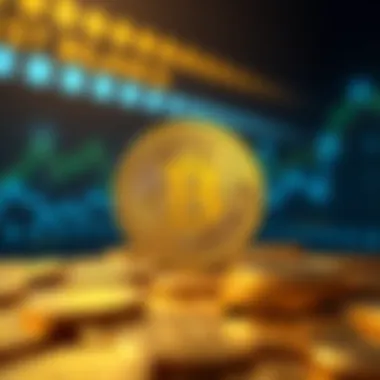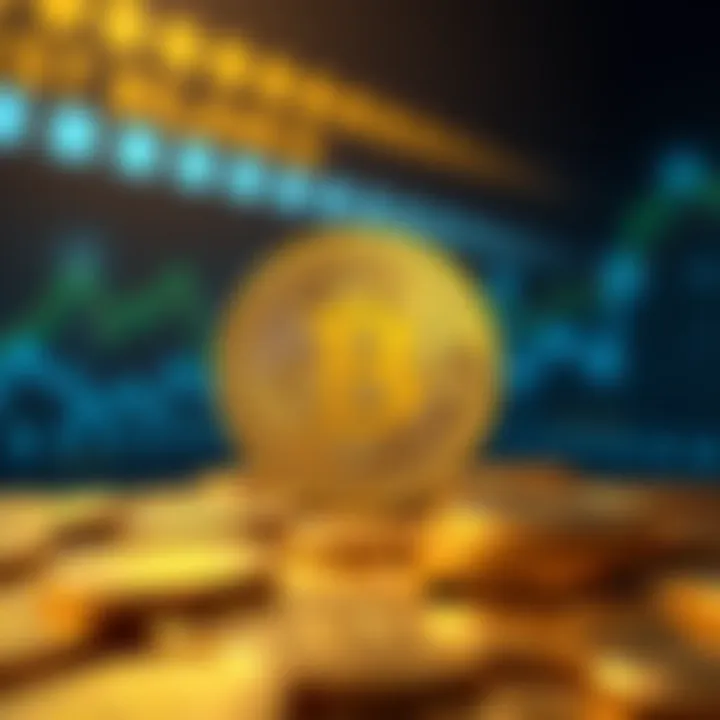Exploring Crypto Backed by Precious Metals for Investors


Intro
As the world of finance dances between tradition and innovation, the merging of cryptocurrency with precious metals stands at a compelling juncture. This intersection, where digital currencies meet tangible assets like gold and silver, presents a fascinating landscape filled with potential. For centuries, these metals have been considered a safe haven in times of uncertainty. Now, they are forging new pathways in the digital space, appealing to both devout crypto enthusiasts and cautious investors alike.
The advent of crypto assets has created an environment where technology meets trust, but it’s important to recognize the value of physical backing. Cryptocurrencies that hold a claim on precious metals offer a hybrid approach that could promote stability in an otherwise volatile market. By anchoring digital currencies to recognized commodities, investors may find a level of security that traditional crypto alone often lacks.
In this exploration, we’ll delve into the fundamentals of cryptocurrency and outline how precious metals can enhance their value, providing stability and reassurance to investors. Moreover, we’ll analyze market trends, regulatory landscapes, and the functional dynamics of these hybrid instruments. Whether you’re a seasoned investor or just dipping your toes into these waters, understanding this unique fusion is essential for navigating the future of finance effectively.
Prelims to Crypto Assets and Precious Metals
In this rapidly evolving financial landscape, the interplay between cryptocurrency and precious metals has taken on heightened significance. The idea of bridging digital currency with tangible assets presents an intriguing paradigm shift, capturing the imaginations of seasoned investors and novices alike. The urgency to understand these connections arises from several factors, including economic uncertainty, inflation fears, and a growing skepticism towards unbacked currencies. In this section, we delve into this intriguing intersection, aiming to clarify key concepts that will come into play throughout this article.
Defining Cryptocurrency
Cryptocurrency, in its simplest form, is a digital or virtual currency that uses cryptography for security. These currencies rely on blockchain technology to facilitate transactions and maintain a decentralized ledger. Unlike traditional currencies issued by central banks, crypto operates on a peer-to-peer basis, allowing for transactions without intermediaries. For example, Bitcoin, the pioneer of this digital revolution, emerged in 2009, advocating for a financial system free from government control.
The uniqueness of cryptocurrencies lies not only in their decentralized nature but also in the potential for programmability. Smart contracts, which are self-executing contracts with the agreement directly written into lines of code, expand the functionality of crypto beyond simple transactions. This flexibility renders cryptocurrencies a fresh avenue for investment and speculation, elevating their relevance in the modern financial toolkit.
Understanding Precious Metals
When one thinks about wealth preservation, precious metals often come to mind. Gold and silver, among others, have been used for centuries as stores of value and have deep historical roots in financial systems. Their intrinsic value, often correlated with economic stability, means that they can serve as a reliable hedge against inflation and currency devaluation.
The allure of precious metals also lies in their tangible nature. While cryptocurrencies can be fraught with volatility, streaking in value within short spans, precious metals tend to reflect more stable market conditions. For instance, during periods of economic turbulence, investors traditionally flock to gold, proving its resilience in times of crisis. Such attributes make the combination of precious metals and cryptocurrencies a captivating topic for discussion.
The Concept of Backing in Finance
In finance, the term backing refers to the collateral or assets that provide security to a financial instrument. It assures investors that the value of a currency or asset is anchored to something tangible. Historically, currencies were often backed by a commodity, most famously the gold standard, where paper money could be exchanged for a specific amount of gold. This backing lent credibility and stability to the currency.
As the world has moved toward fiat currencies, the idea of backing has been eroded. However, the recent trends in cryptocurrencies backed by precious metals represent a return to this age-old practice. The promise of crypto being backed by physical assets enhances trust among users, with the potential for reclaiming the stability that has been lost in modern finance. This rekindled relationship between backing and currency creates a rich landscape for investment and offers new opportunities for both opportunity and security in asset management.
"The integration of precious metals with cryptocurrency can not only restore confidence in digital currencies but also stabilize them, creating a unique investment vehicle that appeals across demographics."
In summary, understanding the foundational elements of cryptocurrency and precious metals is vital for grasping their potential synergy. As we further examine historical contexts, mechanics, and current trends, these critical definitions will provide the baseline for discussing their combined prospects.
Links for further reading:
Historical Context of Precious Metals in Finance
Understanding the history of precious metals in finance provides a crucial backdrop to grasping the current dynamics of cryptocurrencies backed by tangible assets. The relationship between these two sectors is not only fascinating but also significant in drawing lessons from the past. Precious metals, particularly gold and silver, have been used as a measure of value and a medium of exchange for centuries. Their ability to store value, combined with their scarcity, has led to their longstanding appeal. Furthermore, the historical journey from precious metals to fiat currencies reveals fundamental shifts in economic paradigms that paved the way for the modern digital age of money.
As we explore this context, we will uncover how past practices influence present trends in cryptocurrency backed by precious metals. This narrative not only helps in appreciating the trustworthiness of backed cryptocurrencies but also in diagnosing ongoing challenges within the investment landscape. By reflecting on the precedents set by previous monetary practices, we can better reason today’s integration of crypto with tangible assets.
From Gold Standard to Modern Currency
The gold standard, a system where currencies were directly linked to gold, played a pivotal role in shaping financial norms. The era of the gold standard limited the amount of money circulating in an economy, inherently tethering value to physical gold reserves. This arrangement provided stability but also constrained economic growth during times of need. Countries often found themselves restricted in their monetary policy options, unable to expand the money supply without corresponding gold reserves.
However, the gold standard gradually gave way to fiat currency around the mid-20th century. The shift, largely initiated during the Bretton Woods Conference in 1944, marked a departure from metal-based currencies to the fiat monetary system we know today. This change was characterized by the abandonment of gold as a direct backing for paper money.
- Benefits of the Gold Standard:
- Drawbacks of Fiat Currency:
- Stability in value
- Natural checks on inflation
- Clear intrinsic value associated with currency
- Increased susceptibility to inflation
- Erosion of trust without tangible backing
- Central bank manipulations raising market concerns
This transition highlights how precious metals once served as a cornerstone in value preservation but also stresses their gradual relegation as economic needs evolved.
The Rise of Fiat Currency
The rise of fiat currency inevitably changed how value is perceived and treated within economies. While fiat money has provided unprecedented flexibility for governments to manage economic situations—especially during crises—it has also introduced uncertainty in value. Unlike precious metals, which possess intrinsic value, fiat currencies derive their worth from government mandates and the collective trust of users.
The pivotal events in this change include:
- The abandonment of the Bretton Woods system in 1971, which completely disbanded the gold exchange standard.
- The 2008 financial crisis, where unbacked currencies faced scrutiny as faith in central authorities waned.
As digital currencies, including Bitcoin, began to emerge in this milieu, the demand for a balance between tangible value and innovative financing solutions became apparent. Investors began to seek stability through cryptocurrencies backed by gold and silver, merging age-old trust in physical commodities with the advantages offered by digital assets.
Bitcoin and the Demand for Tangible Assets
Bitcoin burst onto the scene in 2009, quickly transforming traditional views on digitized money. Initially seen as a rebellion against the fiat system, Bitcoin's journey has since shown a palpable desire for more stability through the integration of tangible assets. Investors are turning towards crypto backed by precious metals, aligning their investments with the historical reliability of these commodities.


The appeal of Bitcoin is not just in its potential for value appreciation but also in its decentralized nature — a stark contrast to government-controlled fiat currencies. When these digital currencies are backed by physical assets, they offer assurance and transparency that many investors crave.
- Key reasons for this demand include:
- Protection against inflation
- Enhanced security and reduced volatility
- A bridge to traditional asset benefits and crypto liquidity
The Mechanics of Crypto Backed by Precious Metals
The intersection of cryptocurrency and precious metals is more than a mere financial novelty. It encapsulates a shift in how we think about value, asset security, and investment strategies. This section sheds light on the mechanics behind crypto assets backed by precious metals, giving both novice and seasoned investors insight into how this hybrid financial structure operates. Understanding these mechanics is crucial for grasping the advantages and challenges inherent in this evolving market.
How Crypto Collateralization Works
At the heart of crypto backed by precious metals lies the concept of collateralization. In essence, collateralization means that digital currencies are secured by tangible assets—like gold, silver, and other precious metals. For instance, if you own a cryptocurrency that is backed by an ounce of gold, the value of that digital currency is intrinsically linked to the market value of that gold. The process can be broken down into a few simple steps:
- Asset Reserve: A specific quantity of precious metals is held in reserve. This is what provides the fundamental value for the cryptocurrency.
- Tokenization: The precious metal is tokenized, transforming the physical asset into a digital representation that can be traded in the crypto market.
- Value Stability: The worth of the cryptocurrency remains relatively stable because it is pegged to a physical asset that historically maintains value. In times of economic uncertainty, such assets often provide a safe harbor for investors.
The robustness of this system is akin to a safety net. If the value of the cryptocurrency plummets, the asset reserve acts as a buffer, reassuring investors that tangible value underpins their digital holdings.
Common Precious Metals Used in Crypto
When discussing crypto backed by precious metals, a few key players often take center stage. The most common precious metals utilized include:
- Gold: The heavyweight champion, gold has been a store of value for centuries. It’s commonly used because of its historical significance and perceived stability.
- Silver: Often considered both an industrial metal and an investment asset, silver also finds its way into crypto collaterals, diversifying risk.
- Platinum and Palladium: While less common, these metals occasionally play a role in the nascent market of backed cryptocurrencies. Their prices can be volatile yet offer unique opportunities.
Each of these metals brings its characteristics to the table, influencing both market dynamics and investor sentiment.
Mechanisms of Valuation
Valuation in the realm of crypto assets backed by precious metals is critical, as it determines pricing, trading, and overall market perception. Investors need to understand how these valuations are calculated:
- Market Price of Metals: The immediate price that precious metals fetch in the marketplace serves as the primary benchmark. This price fluctuates based on supply and demand dynamics, geopolitical factors, and economic conditions.
- Algorithmic Valuation Models: Many newer projects incorporate complex algorithms that adjust the valuation of the crypto asset in real-time based on market conditions. These models can also factor in historical data, providing a predictive element to valuation.
- Auditing and Transparency: Trust is a significant element. Reputable projects often engage third-party audits of their metal reserves to ensure that the amount is equal to the tokens in circulation. This transparency helps maintain investor confidence.
Understanding these mechanisms equips investors with a better grasp of how their investments link back to the physical world, an essential consideration in times of economic flux.
"Investing in crypto backed by precious metals is like carrying a double-edged sword; it can cut both ways but offers a unique vantage point for astute investors."
For those looking to explore this avenue, enriching yourself further on these subjects through reputable resources such as Wikipedia or Britannica can provide deeper insights.
Current Trends in Crypto-Precious Metal Integration
The merger of cryptocurrency and precious metals is not simply a fleeting trend; it's a substantial shift that bears great significance for investors and the financial landscape at large. This integrated approach harnesses the stable qualities of precious metals, such as gold and silver, while leveraging the transformative capabilities of digital currency. The incorporation of these tangible assets into the crypto ecosystem enriches the security and trustworthiness of digital currencies, providing a robust alternative amidst the volatility inherent in the crypto market.
Market Overview
Today’s market presents a curious juxtaposition: traditionalists still cling to standard investing norms, while savvy investors seek avenues that combine the reliability of precious metals with the innovation of cryptocurrency. Recent reports show that investments in crypto assets backed by physical gold and silver have surged significantly since 2020. As of late 2023, almost 25% of investors are engaging with assets that have a metal counterpart. Results suggest that combining crypto with precious metals caters to consumer desire for stability while participating in the fast-paced world of digital currencies.
- Key Factors Influencing Market Dynamics:
- Global economic pressures
- Rising inflation rates
- Increased skepticism towards sole fiat currencies
With these external pressures, many investors are looking for safety nets. Precious metals have long been viewed as a hedge against inflation, and their marriage with crypto offers a tantalizing glimpse into a more secure future for digital asset holders.
Adoption Rates and User Feedback
Adoption rates for crypto backed by precious metals haven't merely increased; they represent an essential pivot in how individuals and institutions view currency. It’s a brave new world with enthusiastic user feedback. Many investors sing praises about the added layer of security these assets provide, which certainly helps calm anxieties related to price fluctuation.
A recent survey indicated that 70% of crypto users consider the backing of physical metals a major advantage, citing:
- Increased confidence in their investments
- A tangible asset that supports digital value
- Simplified comparison of their crypto assets with traditional markets
Although opinions vary widely among newcomers and traditionalists, one shared sentiment is notable: a greater emphasis on transparency and reliability.
Notable Projects and Innovations
The landscape is rapidly evolving with a slew of notable projects striving to innovate within this niche. Leading the pack is Gold-backed Cryptos, such as Tether Gold (XAUT) and Paxos Gold (PAXG), which provide holders with digital tokens redeemable for physical gold. Other projects include:
- Silver Token (SLV): A modern solution that utilizes silver backing to stabilize prices.
- CoinMetal (CMT): A new startup incorporating environmental measures by using recycled metals for backing, showing a commitment to sustainability alongside innovation.
These initiatives not only foster investment but aim to resolve concerns surrounding liquidity and transparency—a careful consideration for those who are hesitant in this growing domain.
"Integrating precious metals with cryptocurrency is like marrying tradition with innovation, generating enthusiasm across diverse investing practices."
The trend is gathering momentum. As the barriers between the physical and digital worlds continue to dissolve, stakeholders are eyeing this integration with both excitement and skepticism. Investors, whether seasoned or new to the crypto space, must navigate this complex but promising landscape with care, keeping abreast of both benefits and challenges ahead.


Regulatory Considerations
In the ever-evolving landscape of cryptocurrencies, regulatory considerations hold a paramount position, particularly when discussing assets that intertwine with tangible items like gold and silver. The integration of precious metals into the crypto space not only brings about new dimensions of investment strategies but also invites a multitude of regulatory frameworks that investors and developers must navigate. This section aims to shed light on the global regulatory landscape, the legal implications of cryptocurrencies backed by precious metals, and the potential pathways regulators might take in the near future.
Global Regulatory Landscape
The global regulatory landscape for cryptocurrencies is a mixed bag of challenges and opportunities. Different countries have taken varied approaches, from outright bans to encouraging innovation.
- United States: Here, the regulatory bodies are fragmented. The SEC (Securities and Exchange Commission) and the CFTC (Commodity Futures Trading Commission) often have overlapping jurisdictions regarding digital assets. Precious metals in crypto might be classified under commodity regulations, requiring compliance with stringent guidelines.
- European Union: The EU has been proactive in developing a comprehensive regulatory framework through the Markets in Crypto-Assets (MiCA) regulation. This aims to provide legal clarity and ensure investor protection. For crypto backed by precious metals, this could mean higher compliance costs but also greater legitimacy.
- Asia-Pacific: Nations like China have taken a hard line against cryptocurrencies, while others like Japan embrace them. The contrasting regulatory stances affect how crypto backed by precious metals can operate in the region. For instance, Japan's Financial Services Agency has been more supportive, potentially offering a more fertile ground for innovative projects.
This complex regulatory atmosphere requires participants in the market to remain vigilant, as new regulations can pop up like mushrooms after a rainstorm.
Legal Implications of Backed Cryptos
When it comes to cryptocurrencies supported by precious metals, the legal implications are significant. These digital assets often fall into a gray area regarding laws surrounding both cryptocurrencies and commodities. One key aspect revolves around the classification of the asset itself.
- Asset Classification: Depending on the nation, these backed cryptos may be treated as securities, akin to stocks or bonds, or as commodities. This classification can dramatically affect how they are regulated and the legal obligations that issuers must adhere to.
- Consumer Protection: Legal frameworks are evolving to protect consumers against fraudulent schemes. Regulations may require companies that issue such backed cryptocurrencies to undergo audits, thereby ensuring that claims about their physical reserves are valid.
- Taxation: Tax obligations differ widely across jurisdictions. Investors need to be aware of how the crypto's classification affects their tax liabilities on gains. In some instances, profits from trading these assets may be subject to capital gains taxes, while in others, the taxes could be more nuanced.
"Navigating the regulatory waters can feel like walking a tightrope. One wrong move could lead to falling off the edge into the realm of non-compliance."
Future Regulatory Directions
Looking ahead, the trajectory of cryptocurrency regulation, especially for assets backed by precious metals, seems to be leaning towards tightening standards. Several trends can be anticipated:
- Increased Scrutiny: As the market matures, expect regulators to ramp up their scrutiny on crypto backed by tangible assets, focusing on transparency and accuracy in claims regarding backing assets.
- Harmonization of Regulations: Many stakeholders are advocating for a global approach to regulation. This could result in a more unified framework that simplifies international transactions involving backed cryptocurrencies, thereby fostering smoother cross-border trade.
- Technological Integration in Compliance: With the advent of blockchain technology, regulators may harness smart contracts for real-time compliance and reporting. This could be a game-changer, allowing instant auditing of reserves and transactions.
Benefits of Crypto Backed by Precious Metals
The integration of cryptocurrencies with precious metals offers several noteworthy advantages that can reshape investment strategies. This section explores the core benefits that lend a unique appeal to crypto backed by tangible assets. By aligning the volatility of digital currencies with the stability of physical commodities, investors might find a more secure and inviting landscape. Prominent elements include strengthening market confidence, providing inflation resilience, and enhancing overall transparency in transactions.
Stability and Security
The fusion of crypto and precious metals provides a sense of stability that the crypto world often lacks. Unlike typical cryptocurrencies, which can experience explosive fluctuations, metals such as gold and silver uphold intrinsic value. They have been recognized as safe havens for investors through thick and thin.
- When a digital asset is backed by gold, the security of investment improves significantly. Investors can feel more secure knowing there is a tangible asset driving the value of their holdings.
- Moreover, the backing typically requires strict audits and verification processes, fostering a sense of transparency and accountability that digital-only currencies frequently miss.
- The correlation between gold prices and economic instability suggests that in turbulent times, crypto backed by precious metals may exhibit less volatility, potentially serving as a stabilizing force for an investor’s portfolio.
Inflation Hedge
In an era driven by economic unpredictability and the fear of inflation, crypto assets, especially those linked with precious metals, can serve as a vital hedge. Gold and silver have historically been viewed as strong indicators against inflation.
- When inflation rises, the currency's purchasing power often diminishes. In contrast, precious metals tend to climb in value. Thus, investments in crypto backed by gold or silver can provide a buffer during these turbulent financial storms.
- For example, if inflation rises to 5% annually, traditional currencies lose their purchasing power, while precious metals can appreciate, preserving investors’ wealth over time.
- Additionally, linking cryptocurrency to physical commodities help insulates investors from the erosion of value, offering a dual layer of protection against economic fluctuations.
Enhanced Trust and Transparency
Trust is a fundamental aspect for any financial system or investment strategy. Cryptocurrencies backed by precious metals come equipped with mechanisms that potentially enhance trust among users and investors alike.
- The inherent nature of precious metals as a reliable value store promotes investor confidence in the backed crypto. Having a physical asset lends credibility to a digital currency.
- Furthermore, many backing systems incorporate blockchain technology, which allows for transparent transactions. Each transfer can be tracked, ensuring a level of visibility that is often absent in traditional finance. This can be especially appealing in scenarios involving high-value transactions where accountability becomes paramount.
- As more players enter this market, the adoption of these cryptocurrencies might hinge largely on the trust built around these mechanisms, solidifying their role as a serious contender in the financial space.
For further reading on this intersection of digital currencies and physical assets, you might consult resources from Investopedia or Wikipedia.
Feel free to look into additional discussion forums and platforms such as Reddit for a deeper dive into community sentiment and insights.
Challenges and Considerations
When discussing crypto assets backed by precious metals, it is crucial to address the challenges and considerations that accompany this intersection of traditional finance and modern technology. An understanding of these issues not only aids potential investors in navigating this complex landscape but also enhances their appreciation for the intricacies involved. This section dives into three main hurdles: market volatility, liquidity issues, and the challenges of physical storage and security.
Market Volatility
The cryptocurrency market is notorious for its volatility. Daily price fluctuations can range from minimal changes to swings of thousands of dollars within hours. This instability can deter potential investors, especially those who prefer the relative steadiness associated with precious metals like gold and silver. Integrating precious metals with crypto offers some mitigation against this volatility. However, investors should remain cautious. With crypto markets sometimes moving independently of their backing assets, the risk of sharp declines remains a reality.
Consider a scenario where a crypto asset supposedly backed by gold experiences a drastic price drop due to market speculation, while the actual gold price remains stable or even increases. This disconnect could leave investors holding depreciated digital assets despite the stability of the tangible commodity backing it. Therefore, staying informed about market trends, and perhaps leveraging hedging strategies, might be vital tactics for those engaging in this hybrid investment approach.
Liquidity Issues
Liquidity refers to how easily an asset can be converted into cash without significantly affecting its price. In the world of cryptocurrency, liquidity varies widely among different coins and tokens. Some cryptos enjoy high liquidity, facilitating quick transactions, while others might struggle to find buyers in a fluctuating market. This issue can be exacerbated for crypto assets backed by precious metals. While gold and silver themselves are highly liquid, the associated cryptocurrencies may not be.
In practical terms, when an investor wants to cash out their gold-backed crypto during a market downturn, they could find themselves unable to do so quickly, or at a premium loss. It raises concerns about the efficiency of the trading platforms supporting these backed assets. Consideration should also be given to how the backing process might limit liquidity; if a large amount of precious metal is tied to a token, its conversion may be slower than anticipated.
Physical Storage and Security
The tangible aspect of precious metals introduces a series of logistical challenges. When it comes to physical gold and silver, storage solutions can be complex and costly. There’s a greater responsibility placed on the entity managing the physical assets to ensure they are securely stored and protected against various risks, ranging from theft to natural disasters.


Investors must weigh these factors. A common approach involves the use of third-party custodians who specialize in secure storage. However, this route may incur additional fees and complicate the simplicity that many seek in the world of cryptocurrencies. Furthermore, any public evidence of backing (like audit reports or inventory statements) must be both transparent and trustworthy, raising the stakes for knowing whether their assets are truly secure and accessible when needed.
Addressing challenges like market volatility and liquidity issues is vital for buyers to ensure their investment strategies align with both risk tolerance and financial goals.
Future Outlook
Understanding the future outlook of cryptocurrencies backed by precious metals is crucial in navigating the dynamic landscape of investments. As these assets blend the inherent value of physical commodities with the innovative drive of digital currencies, investors and analysts must consider a multitude of factors that could influence market direction and adoption.
Predicted Market Trends
As the economy evolves, certain trends seem to take shape, particularly in the realm of cryptocurrencies tied to tangible assets. One key prediction is the increasing demand for stability in volatile markets. Investors dissatisfied with traditional fiat currencies may be searching for alternatives that provide a measure of security. Recent studies suggest that cost-sensitive markets might witness a surge in interest for assets like gold-backed cryptocurrencies.
Moreover, the notion of consumer confidence in digital currencies will likely rise, as people gravitate towards investments that offer transparency and security. Research from major financial institutions has shown that those investing in backed digital currencies feel an added layer of assurance, knowing their assets are tied to physical commodities, thereby mitigating risks associated with speculations.
Stakeholders may want to keep a close eye on regulatory developments as well. Regions with supportive regulations may serve as fertile ground for the growth of crypto-assets linked to precious metals.
Potential Innovations in the Space
Looking ahead, it is clear that innovative technologies are shaping how crypto backed by precious metals will operate. Various exciting evolutions on the horizon could redefine the market landscape. For instance, integration of blockchain technology with smart contracts can enable seamless tracking of precious metals backing the cryptocurrencies. This might allow for real-time updates to asset valuations, fundamentally altering how transparency is perceived in crypto trades.
Another intriguing possibility lies in the rise of decentralized finance (DeFi) allowing tokenization of precious metals. This could democratize asset access for more investors globally, breaking down the barriers often seen in traditional ownership models. Developing these technologies will require careful planning, though, as ensuring security and addressing compliance must also remain a priority.
Strategic Implications for Investors
For investors, understanding the strategic implications of entering the crypto market backed by precious metals is critical. The dual nature of these assets offers an opportunity, but it also presents challenges. Investors must weigh the benefits of asset diversification against the potential to be caught in market fluctuations.
Before jumping in, it's wise to consider:
- Valuation Stability: Precious metals have maintained intrinsic value over centuries, which could serve as a buffer during market downturns.
- Liquidity Risks: Unlike more traditional cryptocurrencies, liquidity might be hampered by the necessity of physical metal verification.
- Market Research: Staying informed on technological developments and regulatory changes is paramount.
"The future is not something we enter; the future is something we create."
With a focus on evolving trends and innovations, staying prepared can help investors navigate the uncertain waters ahead.
For more insights into market dynamics and regulations, consider visiting Investopedia or CoinDesk.
Case Studies
Case studies play a pivotal role in understanding the dynamics of cryptocurrency backed by precious metals. They offer real-world examples illustrating how theories translate into practice. For investors, these studies highlight successful strategies as well as pitfalls that can serve as cautionary tales. Examining these cases provides insight into how markets operate, how traders react to changes, and the broader economic implications of integrating physical assets with digital currencies.
Successful Implementations of Backed Cryptos
Several projects stand out in the realm of cryptocurrency that is backed by precious metals. For instance, Tether Gold (XAUT) is one of the more notable examples. Each token represents one troy ounce of physical gold. This gives investors the stability of gold, combined with the flexibility of a digital currency. Users can trade their gold-backed tokens on various exchanges, making it easy to liquidate positions without the hassles of physical storage or security.
Another case worth mentioning is Perth Mint Gold Token (PMGT). This initiative combines traditional gold ownership with blockchain technology, allowing for easy buying, selling, and tracking of gold assets. The Perth Mint guarantees the gold's quality, which adds an extra layer of trust for investors who often worry about the authenticity of the backings.
Both of these examples highlight how integrating precious metals into cryptocurrency can appeal to a broad spectrum of investors—from those looking for safe-haven assets to tech-savvy individuals who appreciate blockchain’s transparency. Recent surveys indicate that investors utilizing such products often report increased confidence in their investment strategies, knowing they are backed by tangible assets.
Lessons from Market Failures
Not every crypto venture utilizing precious metals has been successful. A few sobering cases illustrate the potential risks associated with these investments. One high-profile failure involved OneCoin, which claimed to have a gold-backed cryptocurrency but turned out to be a massive Ponzi scheme. Investors were lured by the promise of high returns and the notion that they were investing in a solid, tangible asset. However, the absence of any real backing led to financial ruin for many.
Another case is BitConnect, which used a cloud lending platform that suggested backing by various assets, including precious metals. While the exact details are murky, it was clear that reliance on purported assets led many down a costly path. Investors were left disheartened when the platform collapsed, wiping out billions.
These cautionary tales stress the importance of conducting thorough due diligence. Investors should not only seek out ventures mentioned in the limelight but also critically analyze their sustainability and overall transparency. Understanding the operational framework and reviews could save many from unending nights of regret over poor investment choices.
"In the world of finance, the glitter of gold can sometimes blind the logical view of risks involved."
The End
Case studies, both successes and failures, can offer invaluable insights into the cryptocurrency landscape backed by precious metals. They enable investors to learn from previous mistakes while also allowing them to identify effective strategies that work. In a rapidly evolving market, where individual decisions can lead to significant financial outcomes, gleaning insight from real-world examples can be a game-changer for savvy investors.
End
The exploration of cryptocurrencies backed by precious metals brings to light significant insights into the future of finance. As we’ve assessed throughout this article, the integration of tangible assets like gold and silver into the digital currency landscape is not merely a trend; it represents a paradigm shift in how investments are perceived and managed. This union offers a sense of stability and security that many investors have been yearning for in an unpredictable market.
Summary of Key Insights
- Dual Stability: One of the most compelling points is that crypto assets tied to physical commodities have the potential to mitigate the volatility often seen in traditional cryptocurrencies. By anchoring value in precious metals, these backed cryptocurrencies provide a cushion against market fluctuations, making them an attractive option for long-term investors.
- Investment Diversification: Incorporating physical assets into crypto investments serves as a diversification strategy. This can be particularly appealing in a world where economic uncertainties loom large. By balancing the traditional and the digital, investors can hedge against risk while potentially capitalizing on growth opportunities in both spheres.
- Regulatory Evolution: The article emphasizes that with the rise of precious metals-backed cryptocurrencies, regulatory frameworks are evolving. This evolution aims to foster an environment of trust and credibility, which is crucial for mainstream adoption. Understanding the regulatory landscape is pivotal for investors looking to navigate this new terrain successfully.
- Technological Innovations: The ongoing advancements in blockchain technology are vital in supporting the infrastructure required for these financial products. Innovations like smart contracts and higher degrees of transparency enhance user confidence, which is essential for wider acceptance.
Final Considerations for Investors
Investors must approach this new territory with a well-informed mindset. Here are some actionable considerations:
- Research Thoroughly: Before jumping into precious metals-backed cryptocurrencies, perform due diligence. Understand how the backing works and the stability of the underlying assets.
- Assess Market Trends: Keep an eye on market dynamics and technological advancements that may influence the performance of your investments.
- Diversify Your Portfolio: As with any investment, avoid putting all your eggs in one basket. Consider how these crypto assets complement your existing portfolio.
- Stay Informed on Regulations: Regulatory changes can impact the viability of investments. Be proactive in understanding any forthcoming laws that might affect your holdings.
"In the investment world, knowledge is power; staying informed can make all the difference."
Lastly, while the landscape of cryptocurrencies backed by precious metals is riddled with opportunities, it's also fraught with challenges. Investors who are well-prepared and educated will be better positioned to navigate the complexities of this evolving market and harness its potential for wealth creation.















